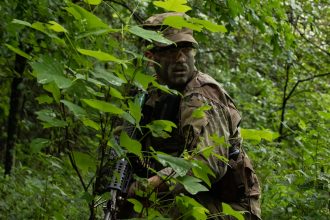Fort Knox, Ky., — Throughout Cadet Summer Training, Cadets learn the meaning of being a Soldier and a leader by exposing themselves every day to new experiences that help them grow. They conquer fears on the Rappel Tower, they develop confidence during Land Navigation and they learn to trust their equipment during the Confidence Chamber.

By the time Cadets arrive at the Field Training Exercise (FTX) their Regiments are a well-oiled machine that is ready to showcase the things they have learned throughout camp, but before they can do that, they must learn one final lesson: How to work with each other.
“Working with people with different types of backgrounds and training on the same thing can be a little difficult because we all have our personal preferences and our ideas on how something should go,” said Baylee Jones, a Cadet from Montana State University. “A few days ago we were definitely a lot more friendly to each other.”
Broken into three different stages, Wolverine, Panther and Grizzly, and spanning over 12 days, the FTX is a war simulation designed to push Cadets physically and mentally. During the Wolverine phase, Cadre provides assistance to the Cadets on the planning stages of the attacks, but as they move into the Panther and Grizzly stages, Cadets take over the training and execute their missions entirely on their own.

According to the Cadre, it is during these days when fatigue and stress begin to crack some of the Cadets.
“Everybody’s challenge is going to be different. Some are able to deal with this type of terrain, and this type of weather, and kind of being probed and having these challenges more so than others,” said Capt. Katherine Huffmyer, a member of the Cadre for 5th Regiment, Advanced Camp, training.
To overcome these hidden challenges of FTX, Cadets must work with each other to accomplish their mission.
“At first we spent a lot of time arguing about it saying ‘my way is better’ but once we figured out that we have to come to a compromise we were able to work,” said Jones.

Her platoon used a divide and conquer approach to smooth the planning process. “We’ll sit around and kind of put forth what we’re used to doing and in that smaller group, in our squads, we would vote on which idea we liked best,” she said. “Then each squad came together as a whole, so there are four different squads, and then we presented four different ideas and voted on those.”
Cadre measures the growth of the Cadets by these displays of leadership, competencies and attributes.
“When we look at from the beginning of the first field exercise in the middle of June to now I have seen a tremendous amount of growth among these Cadets,” said Huffmyer. “I am extremely proud of them.”




